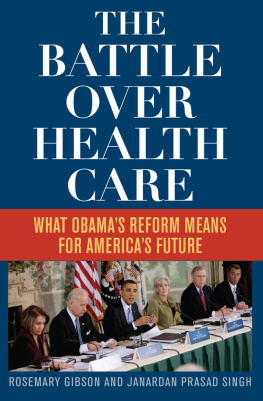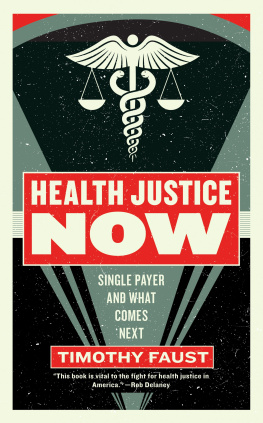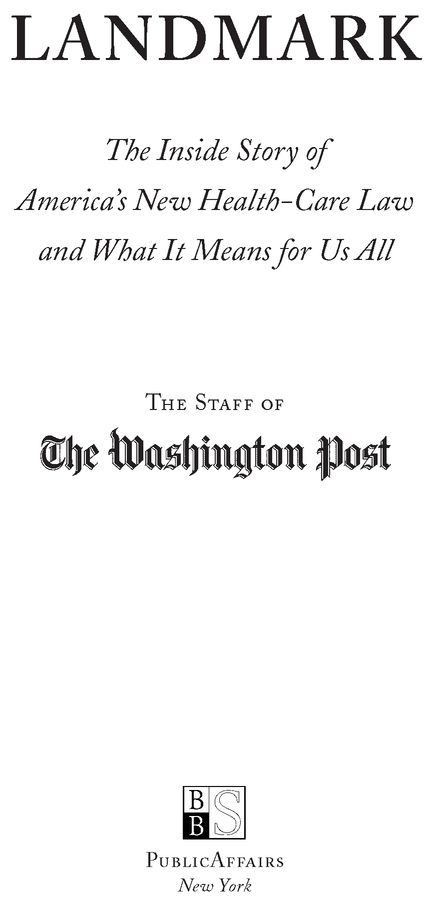Table of Contents
FOREWORD
For more than a century, Americans have debated whether and how to extend health care across society. While politicians argued about what was desirable and what was possible, advances in medicine eradicated diseases, extended life spans and transformed our quality of life.
But there was a cost, and it was vast. Nearly one in every six dollars spent in the worlds most powerful economy went to health care. Yet nearly one in every six people went without coverage that would ensure their access to medical care. The imperative for change loomed ever larger.
In March 2010, Congress acted. The Patient Protection and Affordable Care Act, narrowly passed after a raucous, bitterly partisan debate, will bring about the broadest transformation of the health-care system in this country since Medicare and Medicaid were created nearly half a century ago. Love it or hate itand the nation is as riven as Congress wasthe new law will have an immense impact.
It requires nearly every American to carry health insurance. It compels insurers to cover new clients, even those who are already ill. It alters the way millions of people will shop for insurance. It enlarges some government programs and cuts back on others. For the wealthy, some taxes will rise. For the poor, new subsidies will be available. The governments role in the largest sector of our economy will grow.
It took lawmakers 2,073 pages, before adjustments in a separate follow-up bill, to draft the new architecture of health care in the United States. This book is designed to make sense of it, to put the legalisms into plain English and to explain how they affect us allyou, your family, your doctors, hospitals, insurance companies and many other component parts of this sprawling industry. It also contains an extraordinary behind-the-scenes account of the political calculations and compromises that made the law possible.
The Washington Post has committed dozens of reporters, graphic artists, editors and other news staffers to coverage of the healthcare debate over the past year. Two writers in particular deserve mention. Ceci Connolly reported the inside narrative over many months, informed by interviews with key participants. Alec MacGillis closely followed the development of the legislation and used his expertise to frame this guidebook.
We and our partners at PublicAffairs are pleased to offer you this fascinating tale and invaluable primer to understanding a landmark change in American policy. Whether you welcome or rue the new law, this book is essential reading.
MARCUS BRAUCHLI
Executive Editor
The Washington Post
INTRODUCTION
By Dan Balz
On March 23, 2010, President Barack Obama, using 22 pens, signed the Patient Protection and Affordable Care Act. The import of the ceremony in the East Room of the White House was lost on neither those who supported the measure nor those who had vigorously opposed it. Congressional approval of health-care reform marked the most significant advance in health-care policy since passage of Medicare and Medicaid in 1965. In terms of social welfare legislation, it also ranked alongside the enactment of Social Security in 1935. With his signature, Obama had put his presidency in the history books.
We are a nation that faces its challenges and accepts its responsibilities, he told the audience. We are a nation that does what is hard. What is necessary. What is right. Here, in this country, we shape our own destiny. That is what we do. That is who we are. That is what makes us the United States of America. And we have now just enshrined... the core principle that everybody should have some basic security when it comes to their health care. And it is an extraordinary achievement.
For all the sense of excitement that accompanied the signing ceremony, there was a parallel reality. The health-care bill divided Americans like few other issues in recent memory. Passage came after one of the longest, most rancorous and most partisan debates the capital has seen in years. In pressing for broad reform, the president not only made history, he also put the Democratic Party at risk.
The debate raged for a year. It gave rise to a grass-roots movement of activists who became known as tea partiers and conjured up fears of encroaching big government, sparked angry protests at town hall meetings and tested the capacity of a new president and Democratic majorities in Congress to deliver on their loftiest promises. At times, the legislation appeared stalled. At other times, it was on life support, particularly in the days after a little-known Republican named Scott Brown captured the Massachusetts Senate seat held for more than 40 years by the late Edward M. Kennedy, a Democrat whose name was associated so strongly with the cause of providing health-care coverage to all Americans. In the end, the legislation passed without a single Republican votea far different outcome than for Medicare or Social Security, which ultimately enjoyed bipartisan majorities.
This book chronicles how ideas that had been in the public realm for a century finally became the law of the land, and what it will mean for every person in the country. Americans who wonder how Obama succeeded where so many other presidents failed will find the inside story of the legislative struggle, with all its drama, a compelling narrative of Washington in action. Those who want to know what the fine print in the 2,000-page document (plus the reconciliation bill that cleaned up some of the worst backroom deals) really says can find the answers in these pages. Those who want to read the official summary themselves will also find that in this book.
The account here is the latest chapter in a much longer and richer story. Providing health insurance for all citizens was a goal enunciated early in the 20th century by Theodore Roosevelt. For the past eight decades, many presidents sought to fulfill that vision. Most of them were Democrats, but a few were Republicans. With each effort, a fierce debate erupted, a clash that reflects some of the most deep-seated philosophical questions that have divided the republic since its founding: What is the proper role of government? What is the relationship between government and individuals? What kind of social safety net should government provide to its citizens? Which services are best left to free markets and which warrant federal intervention? Which responsibilities should be given to the federal government and which to the states? And, always, what can the country afford?
Those debates, repeated time and again, were both high-minded and given to extremes. With each effort to expand the system came charges of socialism, socialized medicine and at times talk of Soviet-style health care or the Europeanization of America. Obama faced those accusations as well as others, including the spurious claim that his legislation would establish death panels that would have the power to decide whether Grandma and Grandpa lived or died.
As has often been said, health care is both the most personal and the most complex public policy issue, and the passions it arouses are understandable. To succeed, proponents of reform have had to fight off powerful special interests from the industry, from the American Medical Association to the hospital lobby to the insurance and drug companies. No wonder so many presidents tried without success; no wonder that, even with passage this time, the debate continues to boil across the country.






